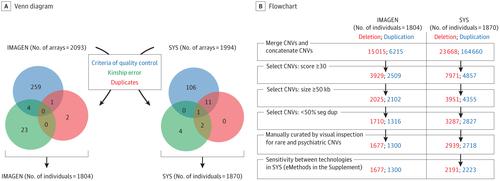JAMA Psychiatry ( IF 22.5 ) Pub Date : 2018-05-01 , DOI: 10.1001/jamapsychiatry.2018.0039 Guillaume Huguet 1, 2 , Catherine Schramm 1, 2, 3 , Elise Douard 1, 2 , Lai Jiang 3 , Aurélie Labbe 4 , Frédérique Tihy 1, 2 , Géraldine Mathonnet 1, 2 , Sonia Nizard 1, 2 , Emmanuelle Lemyre 1, 2 , Alexandre Mathieu 5, 6 , Jean-Baptiste Poline 7 , Eva Loth 8 , Roberto Toro 5, 6 , Gunter Schumann 8 , Patricia Conrod 1, 2, 8 , Zdenka Pausova 9 , Celia Greenwood 3, 10 , Tomas Paus 11, 12, 13 , Thomas Bourgeron 5, 6, 14 , Sébastien Jacquemont 1, 2 ,

|
Importance; Copy number variants (CNVs) classified as pathogenic are identified in 10% to 15% of patients referred for neurodevelopmental disorders. However, their effect sizes on cognitive traits measured as a continuum remain mostly unknown because most of them are too rare to be studied individually using association studies.
Objective To measure and estimate the effect sizes of recurrent and nonrecurrent CNVs on IQ.
Design, Setting, and Participants This study identified all CNVs that were 50 kilobases (kb) or larger in 2 general population cohorts (the IMAGEN project and the Saguenay Youth Study) with measures of IQ. Linear regressions, including functional annotations of genes included in CNVs, were used to identify features to explain their association with IQ. Validation was performed using intraclass correlation that compared IQ estimated by the model with empirical data.
Main Outcomes and Measures Performance IQ (PIQ), verbal IQ (VIQ), and frequency of de novo CNV events.
Results The study included 2090 European adolescents from the IMAGEN study and 1983 children and parents from the Saguenay Youth Study. Of these, genotyping was performed on 1804 individuals from IMAGEN and 977 adolescents, 445 mothers, and 448 fathers (484 families) from the Saguenay Youth Study. We observed 4928 autosomal CNVs larger than 50 kb across both cohorts. For rare deletions, size, number of genes, and exons affect IQ, and each deleted gene is associated with a mean (SE) decrease in PIQ of 0.67 (0.19) points (P = 6 × 10−4); this is not so for rare duplications and frequent CNVs. Among 10 functional annotations, haploinsufficiency scores best explain the association of any deletions with PIQ with a mean (SE) decrease of 2.74 (0.68) points per unit of the probability of being loss-of-function intolerant (P = 8 × 10−5). Results are consistent across cohorts and unaffected by sensitivity analyses removing pathogenic CNVs. There is a 0.75 concordance (95% CI, 0.39-0.91) between the effect size on IQ estimated by our model and IQ loss calculated in previous studies of 15 recurrent CNVs. There is a close association between effect size on IQ and the frequency at which deletions occur de novo (odds ratio, 0.86; 95% CI, 0.84-0.87; P = 2.7 × 10−88). There is a 0.76 concordance (95% CI, 0.41-0.91) between de novo frequency estimated by the model and calculated using data from the DECIPHER database.
Conclusions and Relevance Models trained on nonpathogenic deletions in the general population reliably estimate the effect size of pathogenic deletions and suggest omnigenic associations of haploinsufficiency with IQ. This represents a new framework to study variants too rare to perform individual association studies and can help estimate the cognitive effect of undocumented deletions in the neurodevelopmental clinic.
中文翻译:

测量和估计社区样本中拷贝数变异对一般智力的影响大小
重要性; 在10%到15%的神经发育障碍患者中发现了归类为致病性的拷贝数变异(CNV)。但是,它们对作为连续统测量的认知特征的影响大小仍是未知的,因为它们中的大多数都太少了,无法单独使用关联研究进行研究。
目的 测量和估计复发性和非复发性CNV对智商的影响大小。
设计,环境和参与者 本研究确定了2个普通人群(IMAGEN项目和Saguenay青年研究)中所有智商为50 kb(kb)或更大的CNV。线性回归(包括CNV中包含的基因的功能注释)被用来识别特征以解释其与IQ的关联。使用类内相关性进行验证,该类间相关性将模型估计的智商与经验数据进行比较。
主要结果和衡量 表现智商(PIQ),语言智商(VIQ)和从头CNV事件发生的频率。
结果 研究包括来自IMAGEN研究的2090名欧洲青少年以及来自Saguenay青年研究的1983名儿童和父母。其中,对来自IMAGEN的1804个人和来自Saguenay青年研究的977名青少年,445位母亲和448位父亲(484个家庭)进行了基因分型。我们在两个队列中观察到4928个大于50 kb的常染色体CNV。对于罕见的缺失,大小,基因数量和外显子会影响智商,每个缺失的基因均会导致PIQ的平均(SE)下降0.67(0.19)点(P = 6×10 -4)); 对于罕见的重复和频繁的CNV,情况并非如此。在10个功能注释中,单倍剂量不足分数可以最好地解释任何缺失与PIQ的相关性,其平均(SE)下降2.74(0.68)个点/单位,表现为对功能丧失不耐的可能性(P = 8×10 -5)。整个研究组的结果是一致的,并且不受去除致病性CNV的敏感性分析的影响。由我们的模型估算的智商影响大小与先前对15例复发性CNV的研究计算得出的智商损失之间存在0.75的一致性(95%CI,0.39-0.91)。智商的影响大小与从头开始出现删除的频率之间有着密切的关联(赔率,0.86; 95%CI,0.84-0.87; P = 2.7×10 -88)。由模型估算并使用DECIPHER数据库数据计算的从头频率之间存在0.76的一致性(95%CI,0.41-0.91)。
结论和相关性 模型对普通人群中的非致病性缺失进行了训练,可以可靠地估计出致病性缺失的影响大小,并提示单倍体功能不全与智商的全能关联。这代表了一个新的框架,用于研究过于罕见而无法进行个体关联研究的变体,并且可以帮助估计神经发育临床中未记录的缺失的认知作用。











































 京公网安备 11010802027423号
京公网安备 11010802027423号